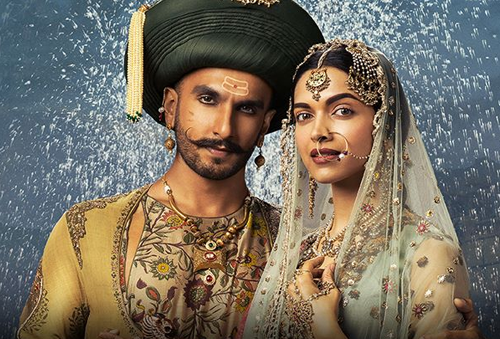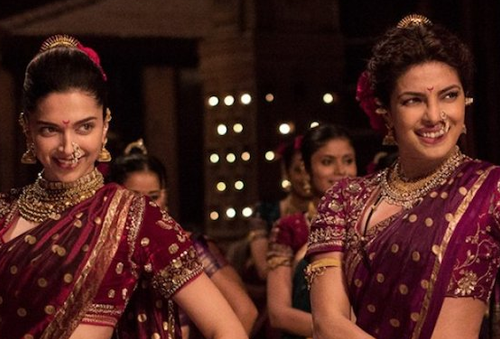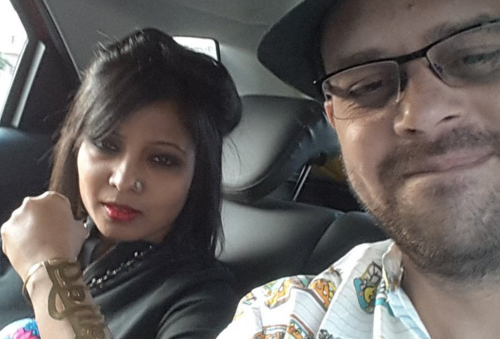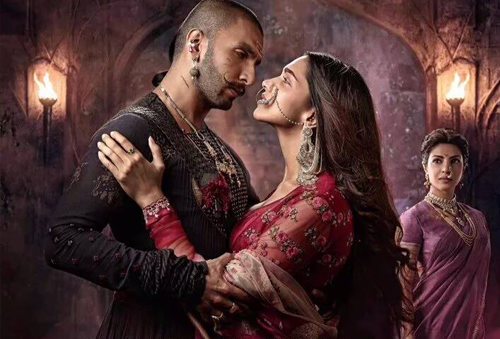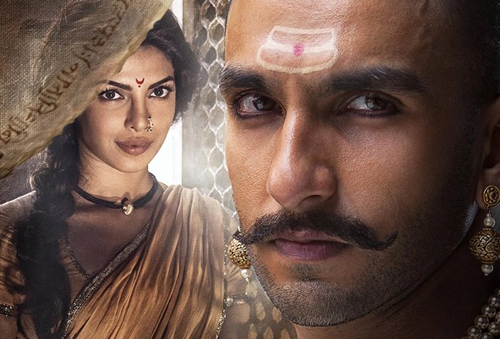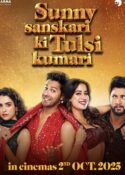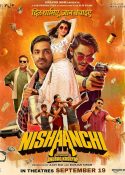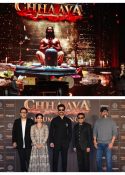We first experienced the magic of Siddharth and Garima’s writing in the Sanjay Leela Bhansali directed Goliyon Ki Rasleela Ram-Leela. The duo, along with Mr. Bhansali, brilliantly transformed the story of Shakespeare’s Romeo and Juliet into an Indian context and the result was rave reviews for the writing and the stars.
For their next project they entered the world of a love story of a warrior – Sanjay Leela Bhansali’s epic Bajirao Mastani starring Ranveer Singh, Deepika Padukone and Priyanka Chopra. For what is being called his magnus opus, Mr Bhansali went to Siddharth and Garima to paint beautiful pictures with their lyrics for three of the biggest songs, ‘Deewani Mastani’, ‘Pinga’ and ‘Mohe Rang Do Laal’.
I was granted the amazing privilege to interview Siddharth and Garima about RamLeela and it was a joy to write the piece. This week, I once again was honored with the chance to interview the duo for Bajiao Mastani and it was a wonderful experience again. Much like the canvas they create with their beautiful lines, their answers for this interview take us on a journey through the writing of the lyrics in the songs of Bajirao, Mastani and KashiBai.
I personally loved reading their amazing, open, insightful and educational answers and I know you will too! In fact, this has now become one of my favorite interviews I have ever written.
Read on to get lost in their amazing answers in this in-depth exclusive interview!
How do you work together to create the incredible lyrics and words you write?
Thanks a lot for the adjective Stacey. But one of the most important things about the lyrics is – the beauty of it lies in the imagery it creates in the mind of the listener. No word would seem beautiful until it’s felt in regards to an emotion.
Writing together is as challenging as it is beautiful. On the exterior, it might seem that one cracks the ‘mukhda’ (opening piece) while the other has a go at cracking the ‘antara’ (stanza), but the fact is that even we don’t know, which one of us has done what. We are two people who come from two very different worlds, two different backgrounds and mindsets. When that merges into one line (mukhda or antara) it’s like a piece with a life of its own. Whether we sit down with a pen and a blank sheet each, on two different tables, or together, it does not matter. The thoughts are in sync and so are the words. Like Sanjay sir puts it – “Even after working with you for 4 years now, I still don’t know which line is written by Siddharth and which one by Garima.” Lots of people have told us that we are the only male-female lyric writing duo ever. Good or bad, it’s for the people to decide once they hear the song.
What to you is the most important thing when you are writing the lyrics to a song?
The character and the situation (read Screenplay). These two things decide the ‘thought’ behind the song. The tone of the film (read Dialogue) determines the kind of words we would use to depict the state of mind of the character/situation. This might sound a little old school to this new generation of Bollywood, but that’s our approach. Most foreign films don’t have songs wound into the screenplay. We feel that’s where we have an advantage. To say a lot of things that cannot be said or need not be said with either the screenplay or the dialogue.
What did Sanjay Leela Bhansali first tell you about Bajirao Mastani?
Oh this is a dream that he’s nurtured for the last 12 years. So there have been a lot of mentions of it even during the making of RamLeela. So we don’t really remember when he had mentioned it to us. But when the music sittings began, is when we knew he had nurtured this dream with great love.
The other thing is that, though the film sounds, feels and is opulent, grand and epic in every detail, inside Sanjay sir’s modest house its like any other film. He doesn’t scale it up in his head and inflict an unnecessary pressure upon himself or anyone else. He gives you space and freedom. He lets you breathe the film and breathe life into it subsequently. While creating the lyrics, he won’t tell you what he has in mind about the picturisation or the visual he has in mind. He lets you create your own visual and fly with it.
For a film like this, with it being an historical epic, about a real person, how do you approach writing lyrics for it?
Once we read the Screenplay, we knew that it was seen through Peshwa Bajirao and Mastani’s lens. The person has a very significant presence in the history of Indian Sub-continent and our audience is very sensitive about that. So we knew that every word would be seen through a magnifying glass to make sure it does not ‘hurt’ anyone. So we had to be careful. Now ‘careful’ is a sad state to be in for a free-minded creative mind. But having said that, it lets you explore a language a tonality that’s been long forgotten. Like paini kataari (curved dagger, used in Pinga antara) can only be written for this kind of a film. The cultural backdrop of the film too gives you an opportunity to explore a different tone.
How did you prepare?
A writer is always preparing. By living and experiencing life and emotions. And then there’s travel. When you are on the go, you are free and when you are free, you absorb. For Bajirao Mastani, we travelled to the interiors of Maharashtra and recorded voice notes of singers who sing Powadas and other traditional folk. Also V Shantaram is a major source of inspiration.
The songs of a film in Indian cinema are such an intrinsic part of the story of a film, how does that guide your pen?
A pen is driven with the potential of an expression, the power of a thought and the hypothetical affect of its expression. A song is fully loaded with all these. It’s like a gold mine, ready to be discovered.
We have grown up on songs. All our childhood memories are marked with songs, more than films. We associate a place, a feeling, a state of mind or an emotion or all of these with a song. It’s an advantage that Indian cinema has over our western counterpart. And unintentionally, the lyric writer has always been a different one from a dialogue or a screenplay writer. One approach is when you do the whole writing (like we did in RamLeela) as one single unit and then the other approach is when you read a full script and approach it with an open mind. Without travelling the path of each and every character, you start where the character is fully formed and alive. The journey might have a different effect while starting off from the fully formed point have a different expression. This is new, a fresh perspective in so many ways. It’s the challenge, the obstacle of discovering the character from scratch that guides your pen.
What starts you off and then how do you go on from that first spark?
The situation and the potential of the situation in our mind is what starts us off. The moment an idea (a situation) hits your mind, sparks fly. And the first sparks are always the most bright. The spark, more often than not, leads you… drives you. Might sound a little esoteric and oft repeated at the same time, but then the song writes itself. It carves its own journey. Then the meter, the pattern takes a backseat and the expression takes a front seat. And if it doesn’t, then you wait. For hours, days (no luxury of months) for the pen to almost pick itself up and flow on the paper. (Yes. We write on paper and not on a laptop).
What did you take from the script to create what the words and the stories you tell in your lyrics for this film?
Mostly, the lyrics express (or at least try) the unsaid. KashiBai (Bajirao’s wife, played by Priyanka Chopra) might not say certain things to Mastani (Bajirao’s other wife/lover, played by Deepika Padukone) in dialogue but she might get away with it via a song. We derive a situation from the script and then express the character’s state of mind with the lyrics.
Since Mr. Bhansali’s movies are so full of grandeur and he paints with such amazing colors and pictures in his scenes as well as amazing stories, how is it to create lyrics for him?
There’s nothing more creatively satisfying than creating lyrics for Sanjay Sir’s films. Like we have said earlier, very few filmmakers understand the value of lyrics. Of late, the value has reduced even more. Gone are the days of music sittings, deriving lyrics out of poetry written by poets.
So this is what we enjoy the most here. Because Sanjay sir creates only in music sittings. He calls for live musicians who play various instruments. When the room brims with their passion, the vibrant music they create, the tunes that Sanjay sir comes up with, makes the words flow.
He makes it seem like an experience. Expression being only a mere consequence of it.
How do you work with him to create these songs?
There are times when our words don’t let him sleep till he puts them to tune and then there are times when we stay up trying to do justice to his tunes by adding our words to them.
At times he has called us late in the night and sang the tune for us. At times, in music sittings we have come with verses/words that blew his mind. (A phrase that stayed with him the longest was Jung Rasiya. It’s not used in the final album though) We think the only thing that can make 3 different minds to work together is mutual respect. Respect for the work.
Does it make a difference since he is both composer and director?
Of course. We think that’s what sets him apart. That’s precisely why his songs stand out. You can only have strong opinions when it comes to a Sanjay Leela Bhansali film. Lyrics in his songs have to express what dialogues can’t. Music has to express what lyrics can’t. He understands that. And we do too. In songs, shot beautifully by legends like Chetan Anand, V Shantaram, Satyajit Ray, Raj Kapoor and many more there’s a reason for everything. The location, the lyrics, the instruments, the raags are all layers that add to the story and take the screenplay forward.
How does the music in style, syncopation and instrumentation affect and lead what your lyrics become?
In common belief, the best lyrics happen when written without the boundaries of a tune. But you know one cannot set a pattern to this. Sometimes the best words come out on set tunes. Every note, every rhythm pattern, every beat is an unspoken word. Once you find that word, it’s magic. It’s music.
There’s no such rule as to what path a song takes. We have never felt that we had to compromise on the lyrics, in order to fit them to a meter or change them according to instrumentation/arrangement of the song. It’s all pre-decided… by a force that makes you create.
We believe that a journey of a song always surprises you. Its like an old fable, waiting to be discovered. And one feels exhilarated at the discovery, once fully formed. Its strange, you invent out of nothing yet feel it was a discovery. You create, yet feel it was created you just crafted it.
How are the titles decided for a song?
Well, normally, these days, the ‘hook’ is cracked first. Then the song is formed and then a film is picked, in which the song fits the most. But that doesn’t happen here.
The titles are mere names, not hooks. They are not made to shock you and grab your attention. We as humans associate a religion, a caste, and some times a face to a name. A name or a title is the most judged upon thing in this world. What’s in a name? Here, in this album, the line/verse that repeats itself is the name. It might not be the best possible ‘hook’ as per the latest trend, but its organic. For eg: The song is called Pinga while Latpat latpat might sound like a better hook.
Let’s talk about the songs you wrote:
Deewani Mastani
What sort of brief did Mr Bhansali give you?
Musically Sanjay Sir had lived with Deewani Mastani for over a decade now… we had heard him humming the notes of this song during the Ramleela phase too! So it was almost like a sketch on a canvas that had to be coloured. Moreover, the brief demanded it to be grand and pristine as the character’s (Mastani’s) dramatic entry into a given situation. It makes for a crucial turning point in the film. So all in all, the brief was to write from the point of view of the character, in a way that its grand yet heartfelt, regal yet sombre, Maraathwad (the maratha land) merging into a sufi scape at the same time.
As the writers, what would you say this song is about?
This song is about the epitome, the beauty, the selflessness and the purity of love. It’s ‘sufi’ and almost devotional in nature. Mastani is the ‘Meera’ in this song. (Meera who hopelessly and selflessly falls in love with an idol of Lord Krishnaand spends the rest of her life devoted to him) The song actually defines Mastani’s love for Bajirao.
What was the most important thing to you as you were creating the story of this song?
The character’s state of mind was of prime importance. She’s in love with a warrior king, a married man and is actually here to profess her love to him amidst a crowd of his people. In a land where she knows no one would approve of her or ‘them’. The most important thing was to find the right words for her to sing… where she communicates what’s in her heart to her lover and actually gets away with it!
What is it like to hear your song sung by Shreya Ghosal?
Oh my god! Shreya is a goddess! She has earlier crooned to our words in Ramleela but this has been even more special. We have only 3 songs in the film and by co-incidence all 3 have been sung by her! We were there for the recording of this song and its a delight watching her sing. She feels what we write from her heart and delivers it like she always knew how its meant to be expressed! According to us, she’s the most versatile and melodious singer of our times. She can sing almost anything, with the right amount of spunk, purity, emotion or even drama! One of the Bajirao music reviews says it is – As if Shreya makes love to the words of Siddharth-Garima – that of course feels awesome! We would love to keep writing for her to sing for us.
The first time you saw the finished picturization with Deepika what were your thoughts?
Honestly we were numbed. Who in today’s ‘chroma key’ and ’30 day quickie schedules’ thinks of creating something like this? Each and every frame in that song is worth its weight in gold. To recreate something from history by creating something completely new… that’s imagination. Each mirror in that ‘aaina mehel’ (mirror palace) is actually pointing to the ‘film makers’ in this country… this is cinema. In its purest form. This is what an audience comes to movies for – a larger than life set, a picture perfect heroine, romance, drama, beauty, music and dance. Sanjay Sir has immortalised Deepika with this one and she looks how she’s never looked before. We had been to the set during the picturisation of the song, but what came together was completely stunning and beyond expectations!
Pinga
What did the director tell you he wanted for this song?
So here’s how it goes – A Marathi traditional dance set up, complete with the Navvari Sarees, the nose pins, buns and the beautiful Marathi women performing together to a devotional number. Two women who are in love with the same man, but are not sure of what they feel for each other. Pathos amidst a celebration, friendship amidst rivalry, discovering acceptance in the rejection, love in the hatred and empathy in estrangement. This was one of the most challenging songs we have ever written. In terms of its traditional folk feel, expression or emotion we had to get the beat right. As always this song had to be a package for Sanjay sir… replete with drama and grandeur a la ‘Dola re Dola’ from Devdas. He wanted it to be a notch higher! So you can imagine!
It has been called a lavani number but it is also based on a folk dance of Maharashtra, how did you prepare and take that into consideration lyrically?
The thing with tradition and history is that it repeats itself. The context, the prerogative, the understanding alters a bit but the essence remains the same. With it being so rooted in folk we had certain words in mind. Neither of us is a Maharashtrian and I think that worked wonders for us. We were clean slates, forming and creating from scratch. Our absorption would always be more as our glasses were empty. And when you rediscover something you walk a thin line. Our preparation was learning. About the culture, the people, their values, their language. Once you do that it becomes easier to express what you feel, in terms of their opinions.
Also the song is picturized on Deepika and Priyanka, how does it feel to have your words be a part of that epic dance?
Initially and for the longest time it was to be picturized on Kashibai and Mastani for us. Much later, it became Priyanka and Deepika respectively. Priyanka was in ‘Ram Chahe Leela’ and Deepika had done another solo for us with ‘Nagada Sang Dhol’. But this time when we saw them together we knew it was larger than life. We love the moment that shines with Sanjay sir’s direction and beautiful choreography (Remo D’souza) where Mastani sings – “Tu jaane ye duniyadaari, main toh hoon bas mohabbat ki maari”. Songs like this happen very rarely and to be a part of that rare phenomenon is the only reason why people like us write. We are lucky to have got the opportunity to do something on the lines of ‘Dola re Dol’a, as both of us have grown up on that song.
How does it feel to hear your lyrics come to life when the singer sings them?
Words are made of letters till they are brought alive by speech. Lyrics are verses looking for the sunlight of a singer’s voice. Inside the silence of a studio, when a singer breathes melody into the words its fulfilling at some other level.
And then to see them onscreen?
It’s different to see your words being sung, woven into music or even being enacted… but it is the final outcome onscreen that makes the entire process surreal! It’s no longer between a pen and paper now… it’s reaching out to people as an emotion. Each lyric is clearly visible in 3D and thus it better be good! We feel songs that are picturised have a far better connect than the ones that are not. In Ramleela, there were at least 2 such beautiful songs (‘Dhoop’ and ‘Laal Ishq’) in the album which couldn’t be shot for the lack of time and space… a lot of people loved them for the melody and lyrics but had they been shot, the connect would be much more and wider. For a lyric writer, seeing a song onscreen could be compared to giving birth. You believe in the potential of what you created when you see it!
Did you worry that this would be compared to ‘Dola Re Dola’?
One beautiful, larger than life set up… traditional dance and two women in love with the same man… ‘Dola Re Dola’ was always looming large over our heads! Sanjay Sir put it as a ‘tall order to match’ and indeed it was. But we always believed that in spite of a similar situation and parameters… each one of these songs (‘Dola Re Dola’ or ‘Pinga’) had a unique quality about them. While ‘Dola re Dola’ was more about the two women describing their love for the man to each other, Pinga was more about Kashibai and Mastani empathising with each other. Each one of them owns Bajirao in her own way but neither of them is complete with him. Each story finds it’s song … here of course the pathos, the tragedy and the large-heartedness of Pinga sets it apart from its precedent. ‘Dola re Dola’ is one of the greatest and grandest songs of all times and yet we are sure that ‘Pinga’ would find its own unique place in the history.
Is it different to write the words of a pure dance number?
Indeed it is! For a dance number it’s of utmost importance that the words are catchy. They need to have a beat of their own. The poetry and thought have to fall exactly in sync with the rhythm and movement. The words need to be smaller and simpler and asking for performance. Though a SLB composition allows you to keep your thought intact even as you play with the words, one has to make sure that the words don’t come in the way of a high-voltage number. Especially for a traditional song like ‘Pinga’, set in a period era, it was as much a challenge to find the right kind of words. Such that they appeal to today’s sensibility also. It remains a fact, long after a film is gone… a dance number would play out on a television show or kids will enthusiastically prepare for a wedding function rehearsing and remembering those words! They better be memorable.
Mohe Rang Do Laal
We have heard it but since we have not seen this yet, if you can tell us, what story within the film does this song relate?
Mohe rang do laal means ‘colour me red’. This song in the film is the moment of Bajirao Mastani falling in love with one another. She refers to him by the name of Krishna (Nand ke laal) in the song because that’s the god she prays to. That’s the god associated with love, playfulness and devotion. Since you haven’t seen the song yet, we should not be telling you much about it. All that we can say is that it is sure to transport you into another era. It brings alive that moment in history when a Peshwa must have witnessed beauty in its truest form. The moment where a Mastani must have given her heart to a warrior, for the rest of her life. It’s the kind of song that lives on.
What inspired the beautiful poetry of this song?
For us, an emotion in its purest form evokes poetry. It could be love, hatred, fear, pride, joy, sadness or anything. The purity, the sanctity of this moment between the two lovers was inspiring. What she sings here is actually like a bhajan (hymn) addressed to the lord, bet she is actually addressing her lover. Its the epitome of her devotion to her love. How we ask the almighty for something, here she asks her lover to colour her red…red for romance, red for passion or red for reverence.
What was the picture you wanted to create with these words?
A beautiful girl almost pleading to her lover to make her fall in love… deep in love. The imagery we had in mind was that of a holi (festival) replete with colours, where a young girl meets her lover (possibly Krishna) and pleads with him to colour her. Even as a banter goes on between the two, she is falling more and more in love with him. The words we used are more in the playful zone – Marodi kalai mori. She imagines a situation where the lover would hold her hand by the wrist so hard that it would break her bangle. That he steals a moment to engulf her in an embrace.
How do you create the lyrics for a classic song like this?
To begin with, we don’t realise or term it as a classic! That surely helps! Because while creating we cannot let that weigh us down. The pen has to be free of any such pressure or else it would sound like a self-proclaimed or ‘wanting to be’ classic! We write the song with as much purity and honesty as it deserves and then being a classic is purely a matter of the song’s fate. As far as a pure classical composition goes, it needs a very pure language and tone. For this song, it had to be a mix of hindi dialects like ’khadi’ boli and ‘braj’ bhasha. Yet the lyrics have to be relatable in today’s times. So we decided to keep the ‘lyrical’ situation relatable, which is a ‘banter’ between a boy and a girl, which has existed in every era, through historical or mythological times. So the trick was to keep the words pure and the reference relatable. Hopefully it would go on to be a classic song of our times!
Once again Shreya brings your words to life, what do you love about her singing your words?
We can’t think of anyone else apart from Shreya who could have sung it better or done as much justice to the lyrics or the composition! And its not just because she has sung all of our other songs or for that matter because she’s our favourite! But because this song is actually her zone. The sheer sincerity in her voice lends itself beautifully to the classical composition and the words. She makes each word perform for its worth. when she sings them, the words begin to play a beautiful role of their own in the song. She makes each and every bit of the song glitter and stand out. We are blessed to have someone like Shreya bringing our words to life!
Of the three you have written, do each of you have a favorite?
That’s a tough one! We have about 3 songs in the film… How do we offend the other two?! Composition wise, each one is unique and in its own league. ‘Deewani Mastani’ is Sufi, ‘Pinga’ is traditional and ‘Mohe rang do laal’ is a classical song… we equally love all the three zones we have been to via each song! We just cannot pick one out of these!
What about the other songs on the album? Do you have a favorite?
It is the most wholesome and melodious album of our times. Each song is worthy of being played on repeat mode. There was a time when Sanjay Sir wasn’t sure if he would make enough time to compose the songs for the film, but we stood by him and constantly cheered for him and bucked him up to create this. Imagine if all this was inside him! The world needed to hear what he had to communicate musically. We are sure no other composer could’ve understood the soundscape of this film better than him. Very few people have an understanding of music like he does and that’s why this album will live on. It breaks through the clutter and how! A M Turaz and Prashant Ingole have done a great job with the lyrics in their songs. ‘Albela Sajan’ is beautifully composed and re-arranged! Great energy and feeling. ‘Gajanana’ is outstanding and has a larger than life feel to it. Though for its sheer energy and madness, our favourite would be ‘Malhari’!
Do you have a favorite picturization?
‘Mohe rang do laal’ picturization is fabulous, but we love ‘Deewani Mastani’. It has as many dimensions as the number of mirrors. The picturization, like a typical SLB song, is multi-layered. It defines Mastani’s character in the most epic manner.
How important do you think a classic film and the music and lyrics from a film like this are to Indian cinema?
This is Indian cinema. This is what we specialize in. It’s this song and dance and magnitude that sets us apart. We might get influenced by the western formats, film-making techniques etc, but what makes us unique is this scale. A certain segment of filmmakers is drifting towards realism, but we feel this is in our blood. That’s why there’s no one like Chetan Anand, Raj Kapoor, Guru Dutt, Vijay Anand, Mani Ratnam, Yash Chopra, V Shantaram or SLB.
What was the most challenging thing?
Writing is subjective. That is the most challenging thing. It’s very difficult to convince anyone. It’s even more difficult to have conviction and hold your ground when people around you are unsure. What’s also challenging is to innovate yourself. To not be opinionated and to be objective. To create you need to have a pure heart and a pure mind. Opinions color your judgment and that shows. In this case, to stay pure to the thought and not get carried away with the possible response, to not get weighed down by the burden of comparisons was the most challenging thing.
What did you love about writing these songs?
These characters. Their world. The opportunity to feel the timelessness of an emotion called love. To write from the point of view of these 2 very different women who love the same man. Such songs broaden your horizon. They let you use the kind of language that’s almost forgotten. They teach you, about the era that’s gone and the time we live in. Of late, Indian society has become far more regressive than what it was. Writing these songs, sort of liberates you. It transports you to a world where women were far more progressive, liberated and free.
What do you think Mr. Bhansali brings out in you as writers?
He lets you stay true to yourself. He forgets the film, the characters, the actors, the situation while creating. He lets you be who and what you are, on paper. He gives madness to the method and method to the madness in us.
What are your thoughts on the whole film? The performances of stars?
It’s beyond anything one can expect. It’s one of the finest films made in the last 40 odd years. There are films and then there’s an experience. Bajirao Mastani will be the most satisfying cinematic experience for anyone who watches the film. Ranveer and Deepika are in never before form and Priyanka is top notch. You will see them in other films post Bajirao Mastani, but this will stay with you forever.
What do you think of lyrics in Hindi films today?
Oh there are so many extraordinarily talented writers out there. People tend to generalize that overall quality of lyrics has reduced but we disagree here. There’s Amitabh Bhattacharya who we feel is insanely versatile. He can write an ‘Afghan Jalebi’ and a ‘Mujhe chhor do mere haal pe’. Then there Sir Irshad Kamil. For him we just want to say – Jo bhi main kehna chahun, barbaad karein alfaaz mere. The kind of words, verses are being used these days are as good (if not better) as the 60s and 70s where the legends like Sahir, kaifi, Javedsaab ruled.
What about the music?
The music has gone through a transition. It’s no longer about an entire album, it’s about that one song. That we feel is a little unfair. But there’s Amit Trivedi. Rahman Sir, Shankar Ehsaan Loy who still get full albums and that’s great. 2 directors cannot make one film together. Similarly a film should have only one music director. We feel this is a phase and this too shall pass.
What else do you have in store?
Our next is Dinesh Vijan’s directorial debut (Sushant Singh Rajput & Kriti Sanon). We have done the story, screenplay, dialogues and lyrics (hopefully) for that. Then there’s a social satire on the sanitation situation of India called Toilet – Ek Prem Katha (Friday Filmworks, Neeraj Pandey). While these are in the casting stage, we are writing for a Yash Raj Films production too.




